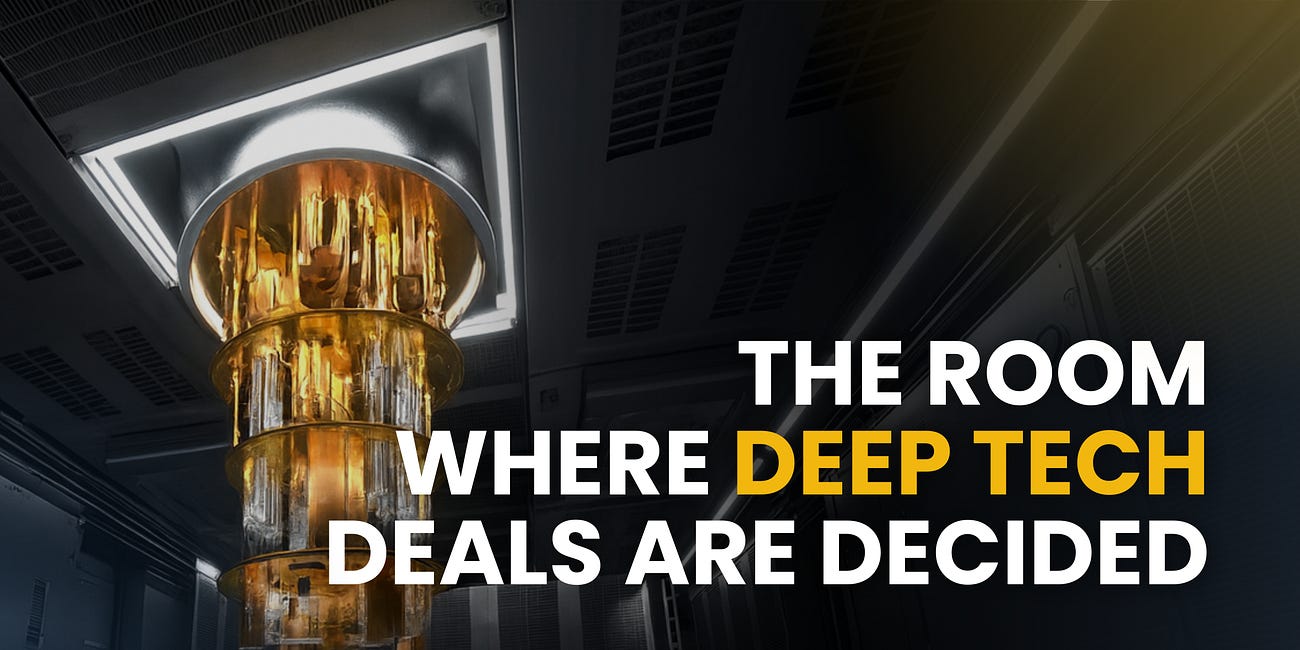Welcome to the 91st edition of Deep Tech Catalyst, the channel from The Scenarionist where science meets venture!
If you're building a Deep Tech startup and find yourself facing longer timelines, tougher markets, and uncertain funding paths—this episode is for you.
Raising capital between milestones is no longer the exception—it's becoming the rule.
With extended time between rounds, increased investor caution, and the operational reality of scaling breakthrough technology, bridge rounds are now a defining part of early-stage venture strategy.
To break down how to approach them with clarity and confidence, we’re joined by Helen Lin, Partner at At One Ventures!
In this episode, we explore:
What a bridge round really signals—and why they’re more common than ever
The data behind the rise in flat and down rounds (and what that means for founders and investors)
What investors look for before saying yes to a bridge
How to structure a bridge round to actually reach your next milestone
Why trust, transparency, and syndicate alignment matter more than ever
If you're navigating the valley of death and wondering how to keep moving forward—don’t miss this one.
Let’s dive in. 🌉
✨ For more, see Membership | Deep Tech Briefing | Insights | VC Guides
BEYOND THE CONVERSATION — STRATEGIC INSIGHTS FROM THE EPISODE
The Reality Behind Bridge Rounds in Deep Tech
A bridge round is not part of the classical funding sequence that most startups pursue—pre-seed, seed, Series A, Series B, and so on. It sits outside that linear path. While traditional rounds are milestone-driven and structured around progression, a bridge round exists because something hasn’t gone according to plan. It’s a financial stopgap that allows a startup to survive between named funding events.
The need for a bridge arises when a company isn’t ready to raise its next primary round—often Series A or B—but can’t afford to wait. The business still holds promise, but it has run out of time or momentum. The term itself reflects the intention: to get from one side of a funding gap to the other, with the hope that the next raise will be viable once certain conditions are met.
Why Bridge Rounds Are Increasingly Common
The rise in bridge rounds is not just anecdotal—it reflects a broader shift in the capital markets and the operational realities of building Deep Tech companies. In the current environment, where investors are more cautious and capital is harder to access, the path between early traction and sustained growth has grown longer and more unpredictable.
Most early-stage companies don’t run out of money because they spent too much on the wrong things. They run out of time. And time, especially in Deep Tech, is expensive. Building physical products, proving scientific hypotheses, and iterating on manufacturing processes—these all take longer than anyone expects.
Founders often begin with a linear roadmap in mind, assuming one cycle of de-risking will be enough. But technology development is rarely linear. You reach the end of a first version only to discover that the product isn’t fit for the customer, and then the cycle begins again.
That iterative nature is not a flaw of Deep Tech; it’s the reality of solving complex, non-obvious problems. But it also means timelines extend, and cash runs short.
Internal and External Pressures Collide
What compounds the difficulty today is the collision of internal and external pressures. Internally, companies hit natural delays due to the time-intensive process of technology validation and early commercialization. Externally, the venture market has shifted into a more risk-averse posture.
Some investors who once backed pre-revenue startups are now demanding several million in sales before writing a check. Series B investors may no longer want to engage until a company looks like it's already ready for Series C. This flight to safety widens the already dangerous “valley of death” between early technical success and commercial validation.
The result is a funding environment where startups, even those that are fundamentally sound, are forced to seek bridge rounds—not because they’re failing, but because the path forward simply takes longer than expected, and investor behavior has shifted.
The Numbers Behind the Trend
Bridge rounds aren’t just becoming more common—they are becoming a defining feature of early-stage venture funding in the current cycle.
In 2024, data collected from sources such as Carta, PitchBook, and Sightline Climate revealed that approximately 40% of rounds at the Series A maturity level were classified as bridge rounds. That figure—four out of ten—is striking for a round that has traditionally marked the beginning of real commercial scaling.
Equally notable is the rise in down rounds, which now account for roughly 20% of all venture rounds over the past two and a half years. A down round occurs when a startup raises new capital at a lower valuation than its previous round—a clear signal that expectations haven’t been met or that market sentiment has shifted. While no founder wants to go through a down round, the data suggests that more are being forced into that position, often as a condition of securing essential capital.
Importantly, these figures are not unique to Deep Tech. They reflect broader market dynamics across venture capital. The scarcity of capital, the slowdown in fundraising, and the increased caution from investors are ecosystem-wide realities.
Longer Gaps Between Named Rounds
Alongside the rise in bridge and down rounds is a less visible but equally significant trend: the elongation of time between primary raises. Historically, a company might raise a Series A, deploy the capital over 12 to 18 months, and be back in the market within two years for a Series B. That cycle has now stretched to more than two years for many companies.
This shift has serious implications. Most early-stage startups are not designed to survive multiple years without fresh capital. If a company finishes its Series A with only early signs of traction—or is still navigating technology de-risk—it may find itself stranded long before it’s ready to attract Series B capital.
What emerges is a liquidity gap that can be fatal without bridge support. And yet, investors are increasingly reluctant to step into earlier stages unless revenue is visible, traction is proven, and technical risks are already resolved.
A Shrinking Middle and the Flight to Safety
The funding gap is further exacerbated by what many in the venture ecosystem describe as a “flight to safety.” Investors are retreating to later-stage deals, moving away from high-risk, early-stage bets. Firms that once backed pre-revenue companies are now drawing lines at a few million in ARR. Series B funds are turning their focus to Series C opportunities.
This retrenchment leaves an already underfunded segment—deep tech companies between seed and Series B—in an even more precarious position. There were never many investors active in this middle space. Now, even fewer remain. The result is a widening and deepening of the valley of death, precisely at the stage when companies need the most capital to move from promising science to scalable business.
The Room Where Deep Tech Deals Are Decided...
Electrons, interconnects, and the leverage that actually closes a deep-tech round.
What Investors Really Want to See Before a Bridge
Series A: The Shift from Technology to Product
The expectations for a Series A round are well established. Investors are not just looking for good science—they’re looking for evidence that the technology has become a product. That distinction is critical, especially in Deep Tech.
By the time a company raises a Series A, it must have significantly de-risked its core technology. Results should be repeatable and well-understood. This is not the stage for early experiments or uncertain outcomes. The technology should be stable enough to support a commercial product, not just an academic demonstration.
Productization is often the hardest leap for Deep Tech founders.
Many are laser-focused on perfecting the underlying science, but that focus can come at the expense of usability, reliability, or economic viability. A repeatable experiment is not a product. A viable product is one that performs at scale, meets specific customer needs, and fits within the economics of a real industry.
Series B: Delivering at Commercial Scale
For Series B, expectations rise sharply. Traction must translate into real, recognized revenue, not just pipeline forecasts or early pilot data. Companies might get by with signed purchase orders or offtake agreements at Series A, but by Series B, delivery is essential.
Investors increasingly look for $5–10 million in annual revenue as a threshold for Series B readiness.
That number is not theoretical—it is what many B-round investors now use as a hard requirement. Booked sales alone are not enough unless they hit that upper range and are backed by credible counterparties.
At this stage, the startup must also demonstrate the ability to scale production and fulfill orders at a commercially viable volume. Demonstrating capacity—whether through small-batch manufacturing or pilot facilities—is no longer optional. It’s table stakes.
The Importance (and Limitations) of Offtake Agreements
In the absence of hard revenue, strong offtake agreements can still serve as a proxy for product-market fit. These are legally binding contracts in which a customer commits to purchasing a certain volume of product over a defined timeframe. They are particularly useful in sectors like advanced manufacturing, where customers want to lock in access to a novel solution that has yet to scale.
But not all offtake agreements are created equal.
Weak agreements can fall apart under scrutiny. Some lack enforceable penalties or clear volume commitments. Others are non-binding or include vague exit clauses that make them unreliable.
Investors have learned to interrogate these agreements closely.
A robust offtake includes specific pricing, volume, delivery schedules, and legal consequences if the customer backs out. The strongest agreements even feature take-or-pay clauses, where the customer agrees to pay regardless of whether they accept the product. These can create predictable cash flow, making them valuable not only for equity investors but also for potential debt providers.
The best offtake agreements validate more than just demand. They imply that the technology is de-risked, the economics are sound, and the production capability is credible. In that sense, they serve as a critical bridge between early-stage traction and full commercial viability.
Who Should You Approach for a Bridge—and When?
When a startup begins exploring a bridge round, the first instinct might be to look outward—toward new investors, family offices, or strategic capital. But the reality is often more constrained. If a company is seeking a bridge, it usually means the external fundraising attempt for a primary round didn’t succeed. And if an outside investor wasn’t willing to lead a priced round, they are unlikely to step in for a bridge, which inherently carries more risk.
That leaves incumbent investors—the ones already on the cap table—as the most viable source of support. In theory, these are the people most aligned with the company’s survival. But even among existing investors, a bridge can be a difficult conversation.
Bridge rounds carry stigma. When a founder comes back asking for more capital before the next planned round, investors naturally ask:
What went wrong?
Why are we here sooner than expected?
Is this a one-time issue or a sign of deeper problems?
Internally, fund managers also face tough scrutiny. Every investment must be re-approved by their own investment committee. Leading a bridge round is often viewed as an implicit admission that the original plan didn’t work—and that can trigger a wave of internal questioning about the investor’s judgment and diligence.
The Investor’s Perspective: What Makes a “Good Ask”?
For incumbent investors, the way a founder communicates the need for a bridge is often as important as the numbers themselves.
What resonates is transparency.
A defensive posture or vague external blaming—“the market is just really tough right now”—erodes confidence. Investors are already aware of macro conditions. What they want to understand is what happened internally and what has been learned.
A clear articulation of the challenges, what went slower than expected, where missteps occurred, and what will change going forward creates alignment. It also enables investors to assess whether the risks are fundamental or simply part of the natural turbulence of scaling a deep tech venture.
In many cases, the conversation becomes a platform for collaboration. If the root issue is a lack of manufacturing expertise, and the investor has internal specialists on staff, that’s a solvable problem. If the issue is commercial traction, the right introductions or sales resources can make a difference. But this only happens when founders are willing to engage in an honest diagnosis of the situation.
Fix the Problem—Not Just the Cash Flow
A bridge round should never be about just plugging a financial hole. It needs to be tied to a credible plan that addresses why the company missed the milestone in the first place. Without that, additional capital is merely buying time—not solving the underlying issue.
The most constructive bridge conversations happen when both founders and investors are aligned not only on the need for capital but on the path forward. In those cases, the capital is paired with operational support, re-prioritized goals, and fresh discipline.
That alignment turns the bridge from a reluctant lifeline into a collaborative tool—one that sets the company up to hit its next real milestone and raise a proper round under stronger conditions.
Designing a Bridge Round—Balancing Conflicting Needs
Designing a bridge round is rarely straightforward. It involves a set of conflicting priorities that must be delicately balanced—starting with valuation.
For incumbent investors, especially those who led the previous round, pricing a new investment presents a structural challenge. They cannot simply mark up their own investment.
As a result, insider-led bridge rounds are often priced flat or even at a down valuation compared to the previous round. This isn’t necessarily a signal of failure—it’s frequently a byproduct of governance norms and valuation ethics. Still, it can be painful for founders, employees, and early shareholders, as it leads to dilution and a visible markdown in company value.
Yet for many companies, the alternative—shutting down or entering distress—is worse. A down round, while difficult, at least gives the company the opportunity to survive, execute, and reach the next inflection point.
Matching Capital to Milestones
One of the most common mistakes in bridge round planning is underestimating how much progress is needed to secure the next primary round. It’s not enough to simply extend the runway. The capital must be directly tied to achieving the milestone that blocked the previous raise.
For example, if a company has raised a Series A and begins fundraising for Series B with only $1 million in revenue, but the market now expects $5–10 million at that stage, a bridge round that gets them to $2 million won’t be meaningful. It just delays the problem. Instead, the company must define a plan—grounded in unit economics and operational clarity—that takes them all the way to that next milestone.
This often requires tough internal trade-offs. Some functions may need to be deprioritized in favor of commercial acceleration. R&D teams building future product versions might be scaled back to free up resources for sales and delivery. Every dollar must be mapped to near-term outcomes that unlock the next round.
Internal Coordination and Investor Dynamics
Bridge rounds often surface the unspoken tensions on a company’s cap table. While founders may brace for hard questions from investors, some of the most heated conversations occur among the investors themselves.
The friction usually arises when not all investors are willing to participate in the bridge. In a situation where three out of four funds step up with capital—and one holds back—it can feel like a free ride. Everyone recognizes that bridge capital is inherently risky. But when one party opts out while still standing to benefit if the company recovers, it can sow mistrust.
These moments test the alignment of the syndicate.
Investors have different internal mandates, fund constraints, and risk tolerances—but when a company is in a fragile moment, a lack of cohesion can complicate execution. Bridge negotiations, rather than being a unified show of support, can devolve into debates over fairness, exposure, and responsibility.
For founders, this dynamic is often invisible until it’s too late. A bridge round that looks viable on paper may fall apart due to interpersonal breakdowns behind the scenes. That’s why maintaining open, transparent relationships with all investors—not just the lead—is essential long before a bridge is even contemplated.
Relationships Are Built Before the Crisis
The companies that navigate bridge rounds most successfully are those that have built strong relational capital with their investors. When founders are consistently transparent—about progress, setbacks, and needs—they earn a level of trust that becomes essential during inflection points.
It’s not just about reporting metrics. It’s about fostering an environment where investors feel included in the problem-solving process, not just informed of the outcome. Founders who demonstrate self-awareness, take accountability, and seek advice early are far more likely to find collaborative partners in moments of difficulty.
When that trust is in place, the bridge round becomes more than just a transaction. It becomes a strategic reset—an opportunity for founders and investors to realign, address root issues, and co-create a path forward.
In contrast, when relationships are frayed or communication has broken down, the bridge can feel like a bailout. Capital is given reluctantly, conditions tighten, and the spirit of partnership erodes. The money might still come, but without shared clarity on how to fix what’s broken, it may only delay the inevitable.
Beyond Capital: The Real Purpose of a Bridge
Ultimately, a bridge round is not about buying time. It’s about buying another chance to execute—with sharper focus, more targeted goals, and stronger alignment between all stakeholders.
When everyone around the table is honest about what went wrong and equally committed to what needs to change, the bridge becomes a catalyst for growth. It reflects the essence of venture partnership: navigating uncertainty, not avoiding it. And in Deep Tech, where timelines are long and milestones are hard-won, that kind of partnership isn’t optional—it’s fundamental.
💸 $100M AI Molecule Search Engine; $58M to Scale Optical Chips; €200M to Accelerate Stellarator Hardware; $6M to Scale Industrial Biocatalysts & more...| Capital Movements Vol. 35
The Weekly Observer of Deep Tech Capital Markets: where the money moves, who drives it, and why it matters.













